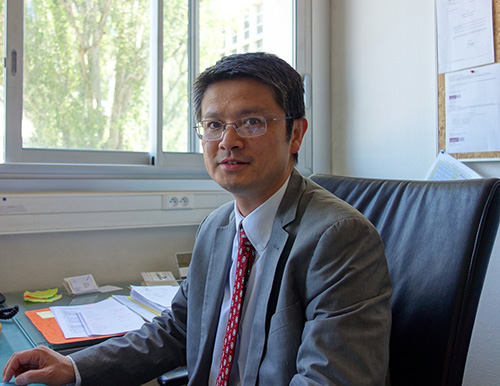Researchers Interview
Keitaro Nakatani (Vice-President for Research, École normale supérieure de Cachan, France)
September 15, 2015

Keitaro Nakatani
- Could you briefly describe your research? What fascinates you most?
I am a researcher in photochemistry who specializes in photoresponsive materials among other subjects, with a particular focus on photochromism. In basic research in this field, a number of different types of studies have been conducted, such as research to develop new molecules showing new properties, and to elucidate new phenomena and quantify related properties. In particular, we have studied how changes in properties (such as solubility, color or luminescence) of photo-switchable molecules occur upon light exposure.
Studying light-matter interaction is on the border between physics and chemistry, and photochemistry is one aspect of this area. Working on subjects at the crossroads of different fields is one of the reasons it is fascinating to me. More generally, in research, an experiment may not always provide the expected result so then we have to think about other ways to reach the targeted outcome. Step by step, it becomes possible to predict the next outcome more accurately. I feel a strong attraction to this type of study and work.
- Could you tell us about collaborative research in which you’ve been involved?
Photochemistry is a field in which Japan is a global research leader. For many decades, there have been collaborations in this area between Japan and France, including my predecessors at my laboratory. More particularly, regarding photochromism, starting in the year 2000, a domestic network of researchers studying photochromism began to take shape in France, and experts in different fields such as synthetic chemistry, physical chemistry, theoretical chemistry, and spectroscopy contributed to the network. Based on a longstanding association, in 2006 a collaborative seminar was conducted by both Japanese and French researchers. It has given rise to an official international network called "PHENICS" (PHoto-switchablE orgaNIC molecular systems & deviceS) supported among others by CNRS (The French National Center for Scientific Research), involving also research groups from nations such as Russia, China, and Germany in addition to France and Japan. The network has provided chances for discussions and exchanges between the partners.
- How would you explain the difference between the research systems in France and Japan?
One typical feature of the public research structure in France is the UMRs (Unités Mixte de Recherché, or "Joint Research Units"), which are units resulting from the association of research organizations such as CNRS and institutions of higher education such as universities. Through this system, in many cases, multiple universities and research bodies cooperate by providing research budgets, researchers and engineers, and administrative staff. Currently, ENS Cachan has 13 laboratories, 11 of which are UMRs with CNRS. Typically, one UMR has several full professors or equivalent level staff, and the system is different from the Japanese academic chair system.
Another difference is that in most cases in France a student starts research in the last semester of his or her second year of their master's course, and carries out research full time in the laboratory once they are enrolled in the doctoral course. In Japan, when students begin a master’s course, they immediately start to engage in research work on a full-time daily basis as a member of a laboratory. When visiting Japan, many French researchers are thus impressed by the number of students in the laboratories, and some of them would like the French students to start laboratory work from an earlier stage, as in Japan.
In France, master’s students have research training for three to four months during the first year of their master’s course. This training is not necessarily carried out in their university, and recently an increasing number of students are going abroad for this. In ENS Cachan, research periods in foreign laboratories were introduced and in many departments students are required to have international experience of this kind. Finally, in ENS Cachan, about 70 percent of the master’s students go on toward doctoral degrees.
- How do you see the current situation at French universities when they apply for outside funding? Could you give some examples from your experience?
In January 2015, Université Paris-Saclay, a federation gathering 19 research and higher education institutions, was formally established. Along with partners such as Universite Paris-Sud and École Polytechnique, ENS Cachan is a founding member. ENS Cachan is now on the way to transfer school buildings into the Saclay area by 2018. With this new system, doctoral and master's degrees are cooperatively conducted within and granted by Université Paris-Saclay. Before its establishment, extensive financial resources through means such as IDEX ("Initiative of Excellence") and LABEX ("Laboratory of Excellence") were granted, making collaboration within the federation possible and deepening the relationships between the partner institutions so that they may gather their forces. As a major part of the French research and higher education policy, these federations are developed on a nationwide scale.
In 2005, ANR (The French National Research Agency) was established, and since then, the proportion of competitive funding for research has been rapidly increasing. As a result, the requirements have changed for academics eager to perform research. Institutions are now changing their organization, in order to adapt their research support systems to be able to handle new schemes. Such changes are also occurring in Japan, and I am strongly in favor of increased opportunities for exchange of opinions and experience between France and Japan, not only between researchers but also administrative staff from both countries.